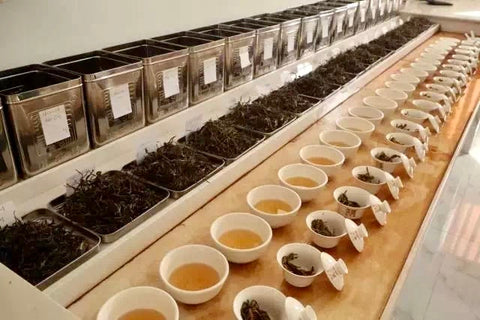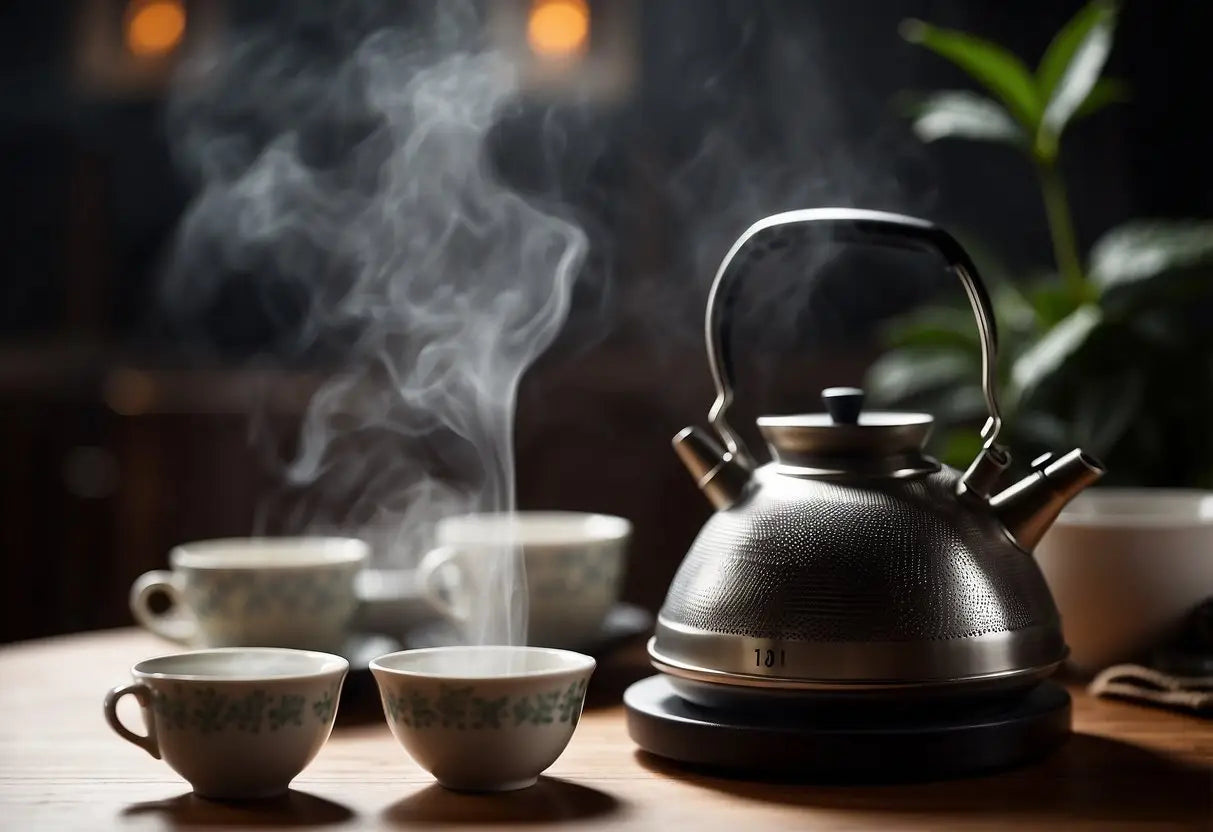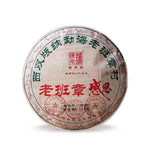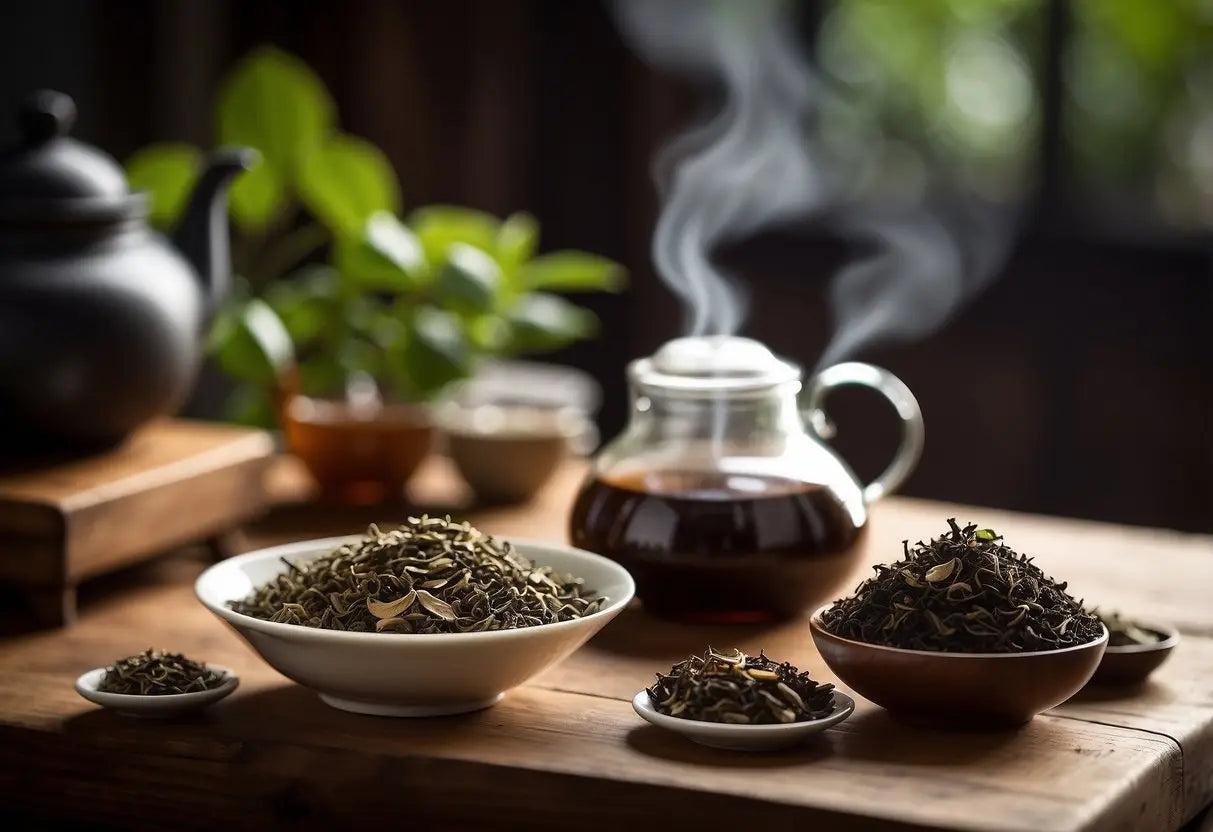Pu Erh vs Oolong
Shop our Pu Erh Tea collections!
Pu-erh tea has a rich history, intertwined with cultural traditions and a specific geographical birthplace.
Historical Significance
Pu-erh tea dates back over 1,700 years to the Han dynasty in ancient China. It gained prestige during the Tang and Song dynasties. Used for medicinal purposes and highly valued for trade, it played a central role in cultural practices, especially in regions like Tibet where brick tea (a form of compressed Pu-erh) was used as currency.
Bestsellers

2022 Pu-Erh Tea Sample Box (Free Shipping)

2022 Yi Pin Chen Sheng Raw Pu-erh Tea Sample Box

2022 Lao Ban Zhang Raw Pu-erh Tea

2022 Na Ka Raw Pu-erh Tea

2023 Ban Zhang Yin Xiang Raw Pu-erh Tea

2017 Rong Pu Ripe Pu-erh Tea
During the Ming dynasty, Pu-erh shifted from being raw to aged, enhancing its flavor and value. The Qing dynasty saw a peak in its popularity, with consumption spreading beyond China to neighboring countries. Pu-erh tea’s historical significance is seen in its influence on trade routes and cultural exchanges.
Geographical Origin
Pu-erh tea originates from Yunnan province in southwest China. The region provides ideal growing conditions with its altitude, climate, and rich biodiversity. Specifically, the tea comes from large-leaf tea trees, some over 1,000 years old, found in the ancient tea forests of Xishuangbanna, Lincang, and Pu-erh County.
Yunnan's diverse microclimates contribute to the unique taste profiles of Pu-erh tea. The Yi, Hani, and Dai ethnic groups have been cultivating and refining the tea-making process for centuries, preserving traditional methods. This geographical specificity ensures that real Pu-erh tea maintains its distinctive characteristics and quality.
Discover our best-selling raw Pu Erh tea and elevate your tea experience today!
Origin and History of Oolong Tea

Oolong tea has a rich history that dates back to ancient China. It is primarily produced in specific regions known for their unique climate and soil, which contribute to Oolong's distinct flavor profile.
Historical Development
Oolong tea's origins trace back to the Tang Dynasty (618–907 AD). It was developed in the Fujian province of China and was originally used as a tribute tea to the emperor. By the Song Dynasty (960–1279 AD), the processing methods had evolved significantly.
The tea was named "Oolong" or "Wulong," meaning "Black Dragon," potentially due to its dark, twisted leaves. The production methods continued to refine through the Ming (1368–1644) and Qing (1644–1912) Dynasties, each bringing unique variations to the tea-making process.
Regions of Production
Oolong tea is predominantly produced in China's Fujian and Guangdong provinces and Taiwan. Each region infuses its distinct characteristics into the tea.
In Fujian, the Wuyi Mountains produce Rock Oolong, known for its mineral-rich taste. Guangdong produces Dan Cong Oolong, celebrated for its floral and fruity notes.
In Taiwan, the central and northern regions, including the Alishan and Dongding mountains, are revered for producing high-quality Oolong with a creamy texture and floral aroma.
Processing Techniques

Lao Ban Zhang

2024 Lao Ban Zhang Ripe Pu-erh Tea

2022 Lao Ban Zhang Raw Pu-erh Tea

2023 Ding Feng- Lao Ban Zhang Raw Pu-erh Tea (42g)

2024 Xiao Ban Zhang Raw Pu-erh Tea

2020 Lao Ban Zhang Raw Pu-erh Tea 125g

2025 Lao Ban Zhang -Gan En Raw Pu-erh Tea 357g
The processing methods for Pu-erh and Oolong teas significantly impact their distinct flavors and characteristics. These methods involve specific steps that alter the tea leaves in unique ways.
Pu-erh Fermentation Processes
Pu-erh tea undergoes a complex fermentation process, crucial for its unique profile. Raw Pu-erh is naturally fermented over time. This aging process can take several years, allowing microbial activity to gradually transform the leaves. Ripe Pu-erh, on the other hand, is artificially fermented through a process known as Wo Dui. This involves piling, dampening, and turning the leaves under specific conditions to expedite fermentation within a few months.
Oolong Tea Oxidation and Rolling
Oolong tea requires partial oxidation, falling between green and black teas. The leaves are first withered under the sun, then gently tossed in baskets to bruise the edges and initiate oxidation. This controlled oxidation process is closely monitored to achieve the desired flavor profile. After oxidation, the leaves are rolled, often multiple times, to enhance their shape and aroma.
Flavor Profiles
Pu-erh tea offers earthy, bold flavors with a smooth finish, while Oolong tea is known for its varied, complex notes ranging from floral to fruity.
Complexity of Pu-erh Flavors
Pu-erh tea's flavor profile is deeply influenced by its aging process. Young Pu-erh features brisk, somewhat astringent notes, often with hints of tobacco or plums. In contrast, aged Pu-erh delivers rich, earthy flavors such as damp forest floors, leather, and even mushrooms.
Fermentation plays a key role. Raw (Sheng) Pu-erh typically has a more vegetal and bright character initially. Ripe (Shou) Pu-erh, on the other hand, offers smoother, mellow flavors such as dark chocolate and dates. These transformations develop an intricate taste experience valued by enthusiasts.
Variety of Oolong Flavors
Oolong tea presents a broad spectrum of tastes depending on its oxidation level. Lightly oxidized Oolongs, like Tie Guan Yin, usually exhibit floral and creamy flavors, often reminiscent of orchids or lilacs. These teas have a light body and a sweet aftertaste.
Heavily oxidized Oolongs, such as Da Hong Pao, lean towards darker, roasted flavors, including nuts, caramel, and stone fruits. This stronger oxidation produces a robust and full-bodied cup. Due to varied processing methods, some Oolongs also present a unique balance between fresh green notes and roasted undertones, showcasing unparalleled versatility.
Health Benefits and Claims

Pu-erh and oolong teas offer distinctive health benefits due to their unique nutritional components and properties. Knowing the specific effects of each can help you choose the tea that best aligns with your health goals.
Nutritional Components of Pu-erh
Pu-erh tea is rich in antioxidants, polyphenols, and catechins. These compounds contribute to its potential benefits. Theanine, an amino acid present in pu-erh, promotes relaxation without drowsiness. Pu-erh also contains small amounts of caffeine.
The fermentation process increases the concentration of probiotics, which support gut health. In addition, pu-erh's compounds may help lower cholesterol and aid weight loss. Regular consumption might improve digestion and boost metabolic rate due to these active components.
Health Effects of Oolong
Oolong tea offers a different set of benefits due to its unique processing method. Oolong contains caffeine, theanine, and a mix of antioxidants. This blend supports mental alertness and may improve cognitive function.
The polyphenols in oolong tea are linked to weight management by promoting fat oxidation. Additionally, oolong has anti-inflammatory properties that might help in reducing the risk of chronic diseases. Drinking oolong could also improve heart health by potentially lowering blood pressure and cholesterol levels.
Brewing Methods

Brewing both Pu-erh and Oolong teas requires specific techniques to bring out their distinct flavors. The right water temperature and steeping duration can make a significant difference.
Optimal Conditions for Pu-erh
Pu-erh tea benefits from a rinse before brewing. Boil water to around 212°F (100°C) and quickly pour it over the tea leaves, then discard this first infusion.
Use 1 tablespoon of Pu-erh per 8 ounces of water. Steep the tea in boiling water for 2-3 minutes for the first infusion. Extend steeping time slightly with each additional infusion.
For the best flavor, use a clay teapot or Gaiwan. This allows the Pu-erh to breathe and develop its complex taste over multiple infusions. Repeat steepings up to eight times, adjusting the time to suit your taste preferences.
Best Practices for Brewing Oolong
Oolong tea requires water heated to around 185-205°F (85-96°C). Use a brewing vessel such as a Gaiwan or a porcelain pot to control the infusion process.
Use 1 to 2 tablespoons of Oolong tea per 8 ounces of water. Steep for 1-3 minutes depending on the desired strength.
Oolong teas are suitable for multiple infusions, often up to five times, with progressively longer steeping times. Swirl the water around the pot or Gaiwan before pouring to evenly distribute the heat and improve the extraction of flavors.
Employing these practices ensures a balanced and aromatic cup of Oolong tea.
Cultural Significance

Pu-erh and Oolong teas hold deep cultural importance in their respective regions, shaping traditions and customs. Each tea's unique history reflects its role in society, ceremonies, and daily life.
Pu-erh in Chinese Tea Culture
Pu-erh tea is deeply ingrained in Chinese tea culture, particularly in Yunnan Province. Its history spans centuries, tied closely to trade routes like the ancient Tea Horse Road. Pu-erh tea is often gifted to signify respect and goodwill. Aged Pu-erh holds particular reverence, often used in special ceremonies and prestigious occasions due to its complexity and valued aging process.
Pu-erh is believed to offer health benefits, influencing its daily consumption in Chinese households. The preparation of Pu-erh involves specific techniques, including rinsing the leaves to "awaken" the tea, a practice that underscores its cultural significance and the detailed appreciation of its flavors.
Oolong's Place in Tea Traditions
Oolong tea is predominantly celebrated in Taiwan and the Fujian Province of China. Its cultivation and processing are considered an art form, often involving rigorous techniques that have been passed down through generations. Oolong tea ceremonies, or Gongfu tea ceremonies, highlight the tea’s importance by emphasizing precise brewing methods to bring out its nuanced flavors.
Oolong tea represents sophistication and hospitality. It is commonly served to guests and during social gatherings, reflecting its role in fostering community and connection. The tea's varied oxidation levels, from light and floral to rich and toasty, showcase the skill and tradition in its production and consumption.
Storage and Aging Potential
Proper storage conditions and aging can impact the flavor profile and quality of both pu-erh and oolong teas. Here’s a closer look at how these elements affect each type.
Aging Process of Pu-erh
Pu-erh tea improves with age under the right conditions. Store it in a dry, cool, and dark environment to promote natural fermentation. Humidity levels should be controlled between 60-70%. Use breathable packaging like paper or cloth to allow airflow, which is crucial for aging.
Over time, pu-erh develops complex flavors, becoming richer and smoother. Aged pu-erh can last decades, gaining value and depth similar to fine wines. Pay attention to any signs of mold or off-smells, as these indicate improper storage.
Storing Oolong for Quality Preservation
Oolong tea does not age in the same way as pu-erh. To preserve its quality, store it in airtight containers to protect it from light, moisture, and strong odors. Vacuum sealing can also be effective for long-term preservation.
Temperature stability is key. Keep oolong in a cool place, ideally below 20°C (68°F). High-quality oolong can stay fresh for years if stored correctly, maintaining its distinct, aromatic flavors. Refrigeration can extend shelf life but must be done carefully to prevent condensation. Regularly check for changes in aroma or appearance to ensure optimal condition.
Market and Consumer Trends
In the specialty tea market, both Pu-erh and Oolong teas have distinct trends influencing their demand and popularity. These trends are shaped by consumer preferences, health benefits, and cultural influences.
Pu-erh Tea Demand
Pu-erh tea has seen a surge in demand due to its health benefits and unique aging process. Consumers appreciate that it can improve digestion and support weight loss. Aged Pu-erh, in particular, is a favorite among tea connoisseurs, and some rare varieties are highly sought after, leading to increased market value.
The demand for Pu-erh is also spurred by its origins and traditional production methods. Many buyers value the authenticity and heritage of Pu-erh tea from Yunnan Province, China. This has driven up interest in both premium and everyday Pu-erh products.
Popularity of Oolong Tea
Oolong tea enjoys popularity because of its broad flavor spectrum and reputed health benefits. It is often chosen for its balance of taste, ranging from sweet and fruity to woody and roasted. Consumers appreciate Oolong’s versatility in preparation and its ability to be enjoyed both hot and iced.
Health-conscious consumers are drawn to Oolong for its potential to boost metabolism and improve overall well-being. Oolong tea is also popular in regions with a strong tea culture, especially Taiwan and China, where it is an integral part of social and cultural practices.
← Older post Newer post →
